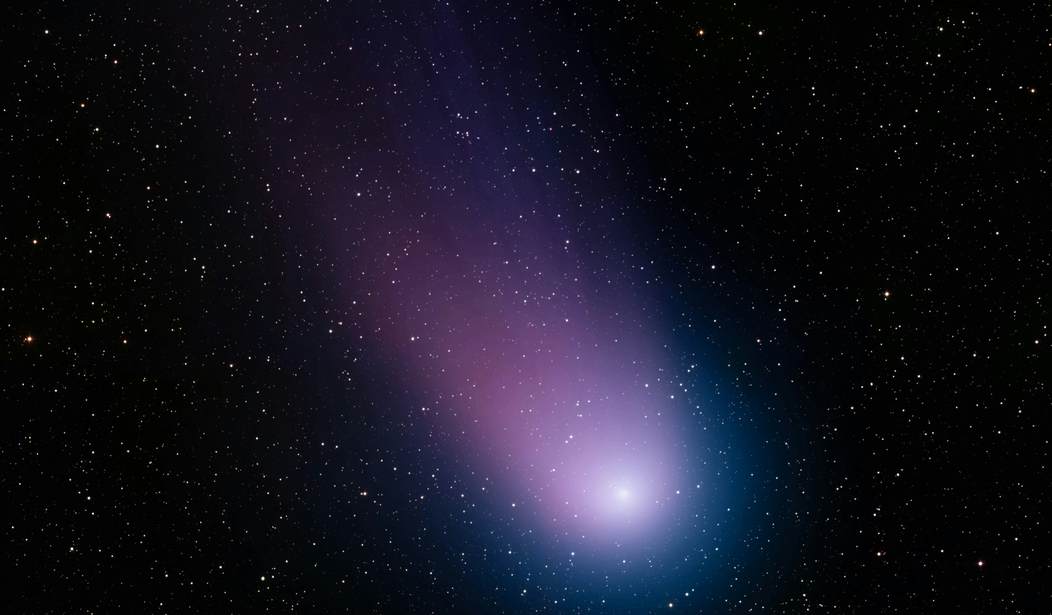Wait, it's not Friday?
Sorry for Friday coming on Monday, but hey, think of it as the teaser for next Friday. Seriously, I had a minor crisis that required a trip to Topeka, which is actually a nice town no matter what anyone tells you. But I came back and promptly got the flu or some damn thing, and I really just recovered more or less this morning. I did a lot of interesting thinking while I was feverish, though.
In the meantime, it's been a great week for comets...
Here's a timelapse of about 40 minutes of movement. You can see not only the movement against the stars, but the way the tail streams away from the nucleus. This is monochrome due to the way I had to cycle through filters to capture color.
— Andrew McCarthy (@AJamesMcCarthy) October 27, 2025
I'm shooting it again tonight. WOW. pic.twitter.com/xrtPtRC5S4
... and aurorae.
Beautiful Aurora in Alaska🌌 pic.twitter.com/KRGpnCwPPz
— Milky Way Astronomers✨ (@fascinatingonX) October 26, 2025
Oh, and photobombing meteors.
Meteor across Comet C/2025 A6 on 25 Oct
— Con Stoitsis (@vivstoitsis) October 26, 2025
27x30s stacked and blended with a single 30s with a meteor.
Credit Valentine Treshchum. pic.twitter.com/UaBolRJQkM
From Mount Everest too.
Comet Lemmon on the Foothills of Mount Everest
— Curiosity (@MAstronomers) October 26, 2025
📷 Luo Hongyang pic.twitter.com/d8TtUQeIlC
The Sun is not taking this lying down.
Here is what pulsating aurora looks like in real-time, not sped up. pic.twitter.com/gcpAGm54da
— Vincent Ledvina (@Vincent_Ledvina) October 26, 2025
Comet Lemmon replies.
Hello Everyone, Comet LEMMMON has been putting on an amazing show, and this is the wildest I have seen the tail. I captured this last night. I used my Celestron RASA telescope, ZWO ASI533MC color camera, and an Antlia L-Filter. pic.twitter.com/5fi4HcL26Y
— Chuck's Astrophotography (@chucksastropho1) October 26, 2025
But there's been other stuff too. (I believe if you click through, Grok will translate the Japanese.)
ジェイムズ・ウェッブ宇宙望遠鏡がとらえた棒渦巻銀河NGC 1300。赤い色は中間赤外線の画像で主に塵が映っています。https://t.co/NIeUngEUQK
— アストロピクス 宇宙画像情報サイト (@Astropics_bb) October 25, 2025
Image Credit: NASA, ESA, CSA, STScI, Janice Lee (STScI), Thomas Williams (Oxford), Rupali Chandar (UToledo), PHANGS Team pic.twitter.com/ExVAMqXWld
I suppose I'm sort of reaching for this one.
🚨🚨: NASA captures ‘cosmic hand’ reaching through 150 light-years of space in stunning new image. pic.twitter.com/DtoZ6U4d4O
— Night Sky Today (@NightSkyToday) October 25, 2025
Orion has so many great views.
M52 Great Orion nebula by Canadian observatory. pic.twitter.com/WSkWg59IAZ
— Julio Maiz (@maiz_julio) October 26, 2025
There have been a lot of pictures of star-forming stellar nurseries recently.
'Star Forming Region S106'
— Swetilein (@Swetilein1) October 25, 2025
Image Credit & Copyright: NASA, ESA, Hubble Legacy Archive; Processing & Copyright: Utkarsh Mishra https://t.co/f7qWIdl6wr 03-25-2020#space #astronomy pic.twitter.com/RVwTqnsBjm
The Grok algorithm has figured out I like astrophotography, and is giving me some great stuff.
Heart of the Rose NGC2237 by Lyman Insley. https://t.co/L3aACS5tSf pic.twitter.com/VBaJFVNNyI
— Julio Maiz (@maiz_julio) October 25, 2025
We really don't have enough time to really see what's happening.
Good morning! Most stars have planets—exoplanet discovery's revolution. Here, baby stars form in NGC 2071 (top) and Messier 78 (middle), 1,600 light-years away, amid dust. They'll rule planetary systems! Have a wonderful day!
— Black Hole (@konstructivizm) October 25, 2025
Credit: ESA/Euclid/Euclid Consortium/NASA, processing… pic.twitter.com/5gO45MPer8
I would like to collect images of the whole life-cycle of a star — not the same star, obviously. This is where the Sun is heading, eventually.
NGC 2371/2: Star's Death
— Black Hole (@konstructivizm) October 23, 2025
Hubble captures a dying Sun-like star's remains in Gemini—a symmetrical planetary nebula of shed layers, glowing gas knots, and jets. Its orange core will fade to a white dwarf. NASA/ESA Hubble pic.twitter.com/A9CGVm4XMj
And this is where they come from. The blue parts are all new stars being formed.
NGC 4303: A Barred Spiral Galaxy in VirgoNGC 4303 (M61) is a barred spiral galaxy located approximately 55 million light-years away in the constellation Virgo. This composite image reveals its structure and star-formation processes through multi-wavelength observations:Yellow… pic.twitter.com/f3TEHZyoPG
— Black Hole (@konstructivizm) October 25, 2025
It wouldn't be sky candy without a shot of the Seven Sisters.
Moon, Venus and the Pleiades😮 pic.twitter.com/ZzDtykZ60c
— Night Sky Today (@NightSkyToday) October 23, 2025
Okay, two.
A Lunar Eclipse and the Pleiades Star Cluster!
— Milky Way Astronomers✨ (@fascinatingonX) October 23, 2025
Image credit: Bray Falls. pic.twitter.com/OEPlgXsleP
Now, this one is just fascinating. I'm sure most of you all know about the mysterious phenomenon called "dark matter" — the way that on a large scale, it appears that there is more mass than can be accounted for by what can be seen. It's easy to think "dark matter" is a thing, but we really don't know that. In this case, "dark" means just "it seems to be there but we can't see it."
Well, in these images, we still can't see it, but we can see how it's affecting starlight passing through it.
Dark Matter's Secret Glow: It Might Not Be Invisible After All! For decades, scientists have insisted that darkmatter—the enigmatic force comprising 85% of the universe's matter—is completely invisible, refusing to mingle with light. But hold onto your telescopes: a… pic.twitter.com/VyI8eBIkmC
— Black Hole (@konstructivizm) October 24, 2025
So, let's finish out the day with another comet in a wonderful composition.
Comet C/2025 A6 (Lemmon) ☄️
— Aleix Roig (@astrocatinfo) October 24, 2025
📷 Steven Robinson
📍Dunning, Scotland 🏔️ pic.twitter.com/5Z05yrucfC
And that finishes it out for today. Sorry it's so late, but there was some great stuff over the weekend so I hope you'll forgive me. As always, I love comments, and I promise next Friday's sky candy will come on Friday.
Which is Halloween.
Hmmm.










